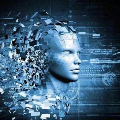This paper is on face/head reenactment where the goal is to transfer the facial pose (3D head orientation and expression) of a target face to a source face. Previous methods focus on learning embedding networks for identity and pose disentanglement which proves to be a rather hard task, degrading the quality of the generated images. We take a different approach, bypassing the training of such networks, by using (fine-tuned) pre-trained GANs which have been shown capable of producing high-quality facial images. Because GANs are characterized by weak controllability, the core of our approach is a method to discover which directions in latent GAN space are responsible for controlling facial pose and expression variations. We present a simple pipeline to learn such directions with the aid of a 3D shape model which, by construction, already captures disentangled directions for facial pose, identity and expression. Moreover, we show that by embedding real images in the GAN latent space, our method can be successfully used for the reenactment of real-world faces. Our method features several favorable properties including using a single source image (one-shot) and enabling cross-person reenactment. Our qualitative and quantitative results show that our approach often produces reenacted faces of significantly higher quality than those produced by state-of-the-art methods for the standard benchmarks of VoxCeleb1 & 2.
翻译:本文在面部/头部再演化上,目标是将目标脸部的面部姿势(3D头部方向和表情)转移到源面。 以往的方法侧重于学习嵌入身份识别网络并造成分解,这证明是一项相当艰巨的任务,降低了所生成图像的质量。 我们采取了不同的方法,绕过这种网络的培训,使用(调制的)经过预先训练、能够产生高质量面部图像的GAN系统。 由于GAN系统的特点是控制能力薄弱,我们的方法的核心是发现潜伏GAN空间中哪些方向负责控制面部和表情变化的方法。 我们展示了一个简单的管道,用3D形状模型来学习这些方向,而3D形状模型已经通过构建来捕捉出面部、身份和表态的分解方向。 此外,我们通过将真实图像嵌入GAN潜在空间,我们的方法可以成功地用于重塑真实世界面部。 我们的方法具有几种有利的属性,包括使用单一源图像(一面部)来控制面部脸部和表情变化。 我们的定性和跨质量模型通常通过生成高质量结果来显示我们的定性和高质量结果。


